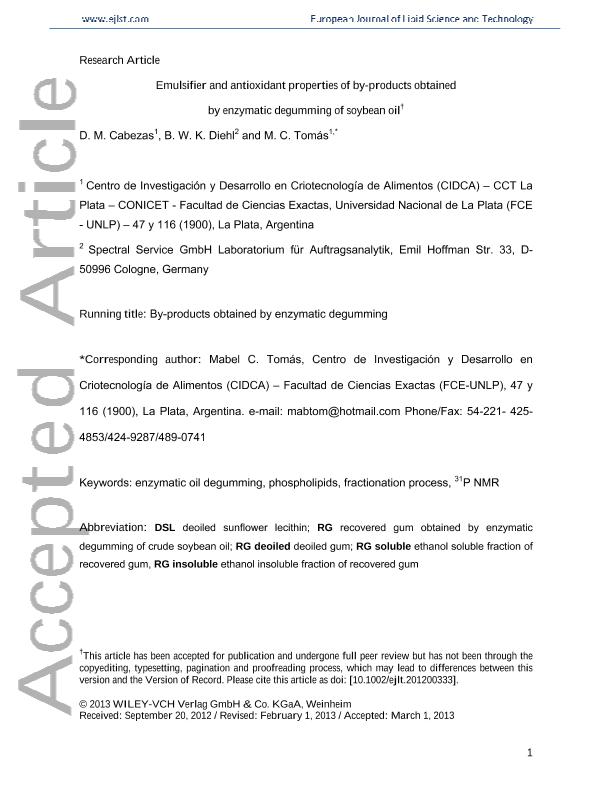Artículo
Emulsifier and antioxidant properties of by-products obtained by enzymatic degumming of soybean oil
Fecha de publicación:
06/2013
Editorial:
Wiley VCH Verlag
Revista:
European Journal Of Lipid Science And Technology
ISSN:
1438-7697
Idioma:
Inglés
Tipo de recurso:
Artículo publicado
Clasificación temática:
Resumen
The enzymes used in degumming, called phospholipases, specifically act on phospholipids without degrading the oil itself. Degumming using a phospholipase C enzyme allows to meet all market specifications while it increases the oil yield. The aim of this study was to evaluate antioxidant and emulsifier properties of the recovered gum (RG) obtained by enzymatic oil degumming process of crude soybean oil subjected to modifications as deoiling (RG deoiled) or ethanol fractionation (RG soluble and insoluble). RG soluble allowed obtaining more stable O/W emulsions (30:70 w/w) in comparison with those by-products assayed at different concentrations (0.1?1.0%). Also, deoiled soybean lecithin (DSL) andRG deoiled had a similar behavior in relation to the kinetic destabilization (%BS profiles), despite the different degumming processes used to obtain these samples. The study on induction times (Metrohm Rancimat) showed a significant antioxidant effect (p<0.05) against a refined sunflower oil associated with all the by-products analyzed. However, RG soluble and DSL showed a strong effect on the oil stability at high concentrations (1000?2000 ppm). These results showed that the deoiled recovered gum and its derivates obtained by ethanol fractionation are a potential alternative for industrial application as additive.
Palabras clave:
31p Nmr
,
Enzymatic Oil Degumming
,
Fractionation Process
,
Phospholipids
Archivos asociados
Licencia
Identificadores
Colecciones
Articulos(CIDCA)
Articulos de CENTRO DE INV EN CRIOTECNOLOGIA DE ALIMENTOS (I)
Articulos de CENTRO DE INV EN CRIOTECNOLOGIA DE ALIMENTOS (I)
Citación
Cabezas, Dario Marcelino; Diehl, B. W. K.; Tomas, Mabel Cristina; Emulsifier and antioxidant properties of by-products obtained by enzymatic degumming of soybean oil; Wiley VCH Verlag; European Journal Of Lipid Science And Technology; 115; 6; 6-2013; 659-667
Compartir
Altmétricas




